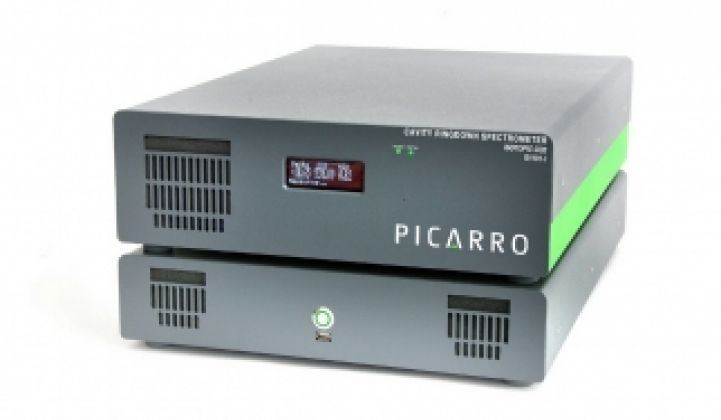Smoke and mirrors: that is one way to think about the Picarro Wavelength-Scanned Cavity Ring Down Spectroscopy instrument.
The $50,000 machine employs lasers and a specially designed chamber that contains three calibrated mirrors that Picarro claims can measure greenhouse gases like carbon dioxide and methane with far more accuracy and geographic specificity than conventional detectors.
The device is also relatively easier to use, which, ideally, will reduce the operating costs and thus the overall cost associated with the process. A pair of researchers put one in a van, for instance, and measured methane levels on a 90-mile drive from Livermore to Sacramento (see below).
The California Air Resources Board today announced it has bought seven of the devices and will soon train 700 technicians how to use them.
The company's product is largely aimed at one of the oft-overlooked problems in the carbon market: the guesswork. Right now, carbon emissions and the efficacy of carbon abatement schemes are often extrapolated from data about energy consumption, business practices, plant absorption rates, etc. Some have suggested the relative vagueness has been a factor in depressing carbon prices.
"Carbon dioxide is at 390 parts per million and we are trying to get it down to 350. We are talking about very small changes," said CEO Mike Woelk. "You need devices that can measure ambient air...Everyone and their mother has a CO2 analyzer, but they are not good enough."
Additionally, Picarro says it can measure emissions down to the plant or municipality level. In the Livermore-to-Sacramento drive, for example, methane levels suddenly spike near animal feed lots and trailer parks. Who should have to pay for carbon abatement? This gives you an idea.
So how does it work? The three mirrors inside the canister form a reflective triangle. Light from the laser bounces off the three mirrors millions of times per second: the pulses of light will travel 20 kilometers in a clockwise direction inside the canister, which only measures about 10 inches in length. The instrument's sensitivity is directly proportional to the length of the test beam.
The speed and behavior of the light in the empty chamber is then measured against the speed and behavior of the light of the chamber when it contains a sample of air. Carbon molecules in the captured air samples will absorb some of the energy. The changes in the light effectively provide raw data for then calculating the level of greenhouse gases.
Still, that price could be a tough one to choke down for a lot of agencies. With seven devices, CARB would be paying $350,000, assuming they pay full price. With the declining price of carbon, it is an open question how much companies will want to spend on instruments. Woelk said he didn't seem to worried about the price. The ease-of-use, along with lower operating fees, can justify it, he argued.
While the device can now identify methane and carbon dioxide levels, future versions may be able to detect more complex molecules like benzene, he said. Picarro also has produced devices for examining different isotopes in water, and ultimately will look at devices for detecting food contamination. If you can detect carbon and water isotopes in a food sample, that gives you a pretty good idea of where the food comes from, he said.
The company has a novel history. It came out of Stanford University as a medical device for measuring breath. Toward the end of the 90s, it became a blue laser company catering to telecom carriers. In 2006, it sold off the telecom portions of the business and became an instrumentation outfit again.
"We originally thought about detecting moisture in natural gas pipelines," he said, but shifted toward greenhouse gases as the carbon market opportunity began to grow.



